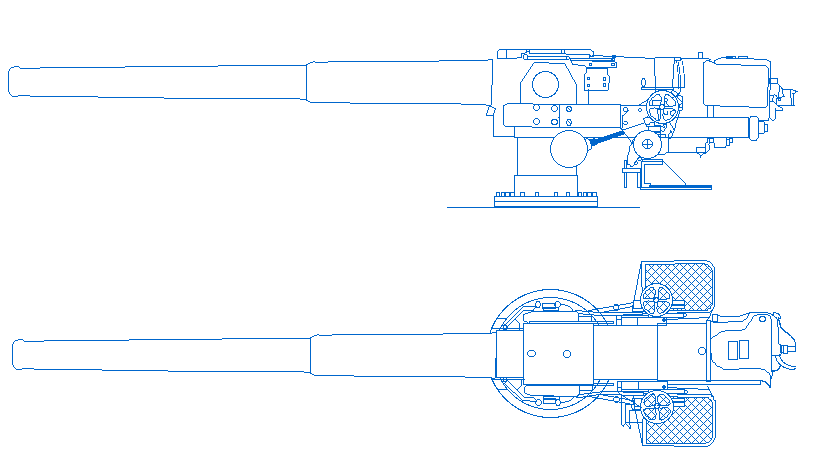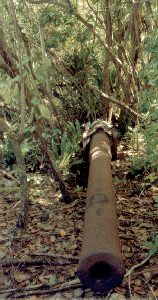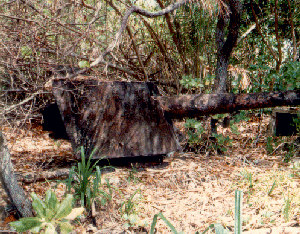

|
Essays on the Marshallese Past
The "Singapore Guns" British Guns in the
|
The Japanese bases in the Marshall Islands had been provided with a wide range of armament by both the Imperial Japanese Navy and the Imperial Japanese Army. The ocean side of the islands was fortified by a series of strong points. Each strong point consisted of one or more batteries of coastal and anti-aircraft or dual purpose heavy guns emplaced in well constructed concrete and coral or coral and coconut-log revetments.
The weapons ranged from a few large naval guns to a number of small arms and countless hand arms. Of these the majority was made in
There is an abundance of heavy guns on the islands fortified by the Japanese, and most of these guns are still in place and can be inspected by visitors.
All guns can always be identified by their barrel numbers, which are punched or ground into the breech block. Some of the 6inch guns on
This abbreviated inscription reads in full: Elswick Ordnance Company 6 inch breech loading Barrel No 15668 Manufactured in 1905
The gun was evidently manufactured by a British ordnance company in 1905. How did it end up on
The heavy guns found in the
It needs to be noted that the Pacific area seems to be replete with "Singapore guns" to such an extent that about ten Singapores could have been equipped. Some of the guns are of British manufacture and thus such a claim is possible. Other guns, however, such as the "Singapore guns" on

Drawing of a British Vickers-Armstrong 6inch Mk II Naval Gun.
The Singapore guns alluded to, were 16inch guns protecting Singapore from the sea, while the heaviest guns seen in the Marshall Islands are 6" coastal defense guns. Therefore the use of the Singapore guns in the Marshall Islands can be ruled out.
However, there is still potential that some of the smaller guns were taken from Singapore and relocated to the Pacific bases then still under construction or nearing completion.

Six-inch coastal defense gun on original location on Mile island. The gun was manufactured in 1905 by the Elswick Ordnance Company in the U.K. for a Japanese warship. After the ship had been scrapped following the Washington naval limitation treaty of 1922 the gun was kept mothballed and was finally emplaced at the eastern perimeter of the Japanese Mandated Territory of Micronesia.
The Japanese navy, following centuries of self-imposed isolation, showed in the 1895 Sino-Japanese war that it was a respectable fighting force. By the same token, it had become apparent that the quality of the naval vessels was sufficient in combat against the Chinese, such as at Yalu and Wei-ha-wei, but that the capacity of the fleet was insufficient to meet another potential enemy,
As a result of the Sino-Japanese war the Japanese navy decided to step up ordering ships from what was at the time the country with the most advanced navy and the most advanced dockyards: the
In addition, ships were built by a dockyard in

Turreted six-inch coastal defense gun on original location on Wotje. The gun was manufactured in 1901 by the Elswick Ordnance Company in the U.K. for a Japanese warship.
Turret of a six-inch coastal defense gun on original location on Taroa.
In the Marshall Islands we have guns of an earlier 6 inch type on
The Historic Preservation Office is now in communication with archival sources in the ![]()
| select from the following... | ||||||
| |
||||||
|
Digital Micronesia-An
Electronic
Library & Archive
is provided free of charge
as an advertising-free
information service
for the world community. It is being maintained by Dirk
HR Spennemann, Associate
Professor in Cultural
Heritage Management, Institute of Land, Water and Society and School
of Environmental & Information Sciences, Charles
Sturt University,
Albury, Australia. The server
space and technical support are provided by Charles
Sturt University as part of its commitment
to regional engagement. Environmental
SciencesInformation
Sciences
|
||||||